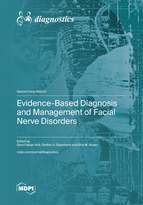Evidence-Based Diagnosis and Management of Facial Nerve Disorders
A special issue of Diagnostics (ISSN 2075-4418). This special issue belongs to the section "Pathology and Molecular Diagnostics".
Deadline for manuscript submissions: closed (30 June 2022) | Viewed by 28064
Special Issue Editors
Interests: facial nerve disorders; rehabilitation; functional electrostimulation; ultrasound; electromyography; quantification of nerve regeneration; mri; 3D-imaging; cochlea implants; otorhinolaryngology; vocal fold palsy
Interests: plastic, reconstructive and aesthetic surgery; hand surgery; Dupuytren's disease
Interests: microsurgery; plastic and reconstructive surgery; reconstructive surgery; aesthetic surgery; microvascular surgery; facial plastic surgery; head and neck surgery; nerve regeneration; surgical flaps; free tissue flaps
Special Issue Information
Dear Colleagues,
With increasing speed, new diagnostic and therapeutic approaches for the management of facial nerve disorders are being published. Many of them have improved decision making, pharmacological and surgical treatment, and the rehabilitation of patients. Unfortunately, there is often a lack of high-quality studies that prove long-term effect or identify subgroups that are of particular benefit. Even a reliable characterization of patients with facial nerve disabilities is often complicated. Therefore, evidence-based management remains challenging.
Novel clinical and technological solutions, such as Patient-Related Outcome Measures (PROMs), telemedicine, 3D motion-capture systems, multi-channel electromyography, ultrasonographic and magnetic resonance imaging, app-based patient follow-up, big-data analysis and machine learning, practice guidelines, or classification based on decision trees, among others, as well as basic research to better understand the pathomechanism might not only enhance our knowledge about impacts of facial nerve disorders, ability to characterize patients, and interventional effects, but might also pave the way towards more evidence-based paradigms.
Therefore, this Special Issue aims to provide an overview of the clinical and technological applications which hold promise to improve diagnosis, clinical characterization, therorecial understanding, and treatment of facial nerve disabilities.
Dr. Gerd Fabian Volk
Prof. Dr. Steffen U. Eisenhardt
Prof. Dr. Shai M. Rozen
Guest Editors
Manuscript Submission Information
Manuscripts should be submitted online at www.mdpi.com by registering and logging in to this website. Once you are registered, click here to go to the submission form. Manuscripts can be submitted until the deadline. All submissions that pass pre-check are peer-reviewed. Accepted papers will be published continuously in the journal (as soon as accepted) and will be listed together on the special issue website. Research articles, review articles as well as short communications are invited. For planned papers, a title and short abstract (about 100 words) can be sent to the Editorial Office for announcement on this website.
Submitted manuscripts should not have been published previously, nor be under consideration for publication elsewhere (except conference proceedings papers). All manuscripts are thoroughly refereed through a single-blind peer-review process. A guide for authors and other relevant information for submission of manuscripts is available on the Instructions for Authors page. Diagnostics is an international peer-reviewed open access semimonthly journal published by MDPI.
Please visit the Instructions for Authors page before submitting a manuscript. The Article Processing Charge (APC) for publication in this open access journal is 2600 CHF (Swiss Francs). Submitted papers should be well formatted and use good English. Authors may use MDPI's English editing service prior to publication or during author revisions.
Keywords
- facial nerve disorders
- facial palsy
- facial paralysis
- facial impairment
- non-verbal communications
- surgery
- rehabilitation
- functional electrostimulation
- ultrasound
- MRI
- 3D-imaging
- machine learning
- evidence-based medicine
- telemedizin









